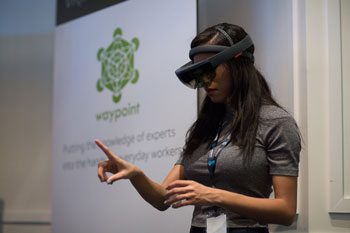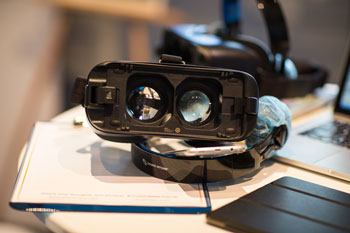5 Essential steps to become a mixed reality developer and why to do it
 It’s an exciting time to be a Mixed Reality (MR) developer. Apple’s WWDC keynote gave Augmented Reality (AR) a huge boost thanks to an eye-catching demo and new SDK, while Google’s used its I/O conference to unveil a new, self-contained Virtual Reality (VR) hardware platform that eliminates the need for a computer or smartphone to drive the experience. According to research from the International Data Corporation (IDC), worldwide revenues for the AR and VR markers will top $162 billion in 2020—which means the demand for developers that understand how to create compelling mixed reality experiences has never been higher.
It’s an exciting time to be a Mixed Reality (MR) developer. Apple’s WWDC keynote gave Augmented Reality (AR) a huge boost thanks to an eye-catching demo and new SDK, while Google’s used its I/O conference to unveil a new, self-contained Virtual Reality (VR) hardware platform that eliminates the need for a computer or smartphone to drive the experience. According to research from the International Data Corporation (IDC), worldwide revenues for the AR and VR markers will top $162 billion in 2020—which means the demand for developers that understand how to create compelling mixed reality experiences has never been higher.
Arriving alongside the new AR and VR software is compelling new MR hardware that harnesses the latest design breakthroughs. The technology includes VR headsets like the HTC Vive and Oculus Rift, Microsoft’s mixed reality Hololens (and offshoots, like the Acer Windows 10 Mixed Reality headset), and Google’s smartphone AR platform Tango and VR platform Daydream. All this new tech means experienced developers have options, though they may have to learn a whole new discipline to take advantage of these emerging opportunities.
Mixed reality developers are in high demand, with companies desperately hunting for qualified applicants. MR developers require a mix of skills, including excellent software programming ability, experience in video and sound production, a proficiency in game development, and strong 3D and UI/UX skills. Since VR and AR development is underway across a range of industries—MR experiences are being created for games and movies, but also education, medicine, sales, trades, and military training—so a diverse background is also desirable.
“As I was working my way through art school, I never pictured myself as any kind of developer much less as an Augmented Reality developer,” wrote developer Ben Rubey in a piece titled How I became a Unity 3D and Augmented Reality developer. “Over the years I had taken a few programming classes but I had never considered programming or software development a viable career path. Fast forward four months and here I am, independently programming Augmented Reality apps in Unity 3D.”
5 Key Steps in Becoming a Mixed Reality Developer
 How can a person go from art school student to Unity developer in just a few months? Though there are many paths a person can take to become a developer, there are a few essential steps that anyone can take to help advance the process and end up coding amazing VR or AR experiences in no time.
How can a person go from art school student to Unity developer in just a few months? Though there are many paths a person can take to become a developer, there are a few essential steps that anyone can take to help advance the process and end up coding amazing VR or AR experiences in no time.
- Pick a Specialty
Developing for mixed reality requires the teamwork of talented people working in different yet related disciplines. There’s User Experience (UX) and User Interface (UI) designers developing the look, feel, and flow of a VR experience. There’s also Unity developers who write the code that becomes the foundation of MR experiences, and 3D Modelers and animators who bring amazing 3D imagery to life. Keeping tabs on it all are Project Managers toiling to help ensure the whole enterprise stays on schedule and under-budget. Though developers often try out different roles until they find the right one, they do usually specialize. It’s up to the individual to figure just which part of the design process they can contribute to most. - Get Some Formal Training
The good news: Developer training is readily available, whether you want to go the self-directed route (check out Quill18Creates on YouTube!) or are interested in a more formal education. Developers typically want to start with either Unity or Unreal, and both provide free online tutorials to get your feet wet. For those interested in a more formal education, Kahn Academy offers courses in programming, while both Harvard and MIT have university-level degrees available in multiple facets of development. - Learn Everything You Can About the Technology
Though it’s good to be hardware agnostic—i.e., open to developing for whatever new gadget emerges from the skunkworks of the Google’s and Microsoft’s of the world—you’re going to have to learn all you can about the current generation of hardware. Fortunately, the companies behind the cutting edge tech typically provide tools to help would-be developers harness the new technologies. This includes HTC’s Vive Developer portal, Facebook’s Oculus developer portal, Microsoft’s HoloLens development community, and Google’s Tango developer support site. - Get a Dev Kit, Attend a Hackathon
Virtually all of the major hardware manufacturers offer kits for would-be developers to learn about their platforms and see what they can build. This includes HTC Vive SteamVR SDK, Oculus SDK, Microsoft’s “Install The Tools” HoloLens developer site, and many more. The cost of a developer kit can vary all the way from free, as it was for early HTC Vive kits, up to thousands of dollars (for example, $3,000 is the going rate for a Hololens Kit). No matter your budget, getting your hands on the actual hardware you want to develop for is a necessity. Once you’ve studied up, it’s time to put your new skills to the test. And what better way to test your metal than by attending a hackathon? The events are a great way to see how your knowledge stacks up against other aspiring developers, and an opportunity to network, and see what else you can learn. - Go Where the Jobs Are
So now you’re fully educated in the ways of developing for virtual and augmented reality hardware and software platforms. You’ve learned your SDK, and are ready to show the world what you know. So where are all the jobs? There are a wealth of online resources that look to match companies with developers in search of work. These include guru.com, a freelance site that allows user to filter through AR/VR/MR freelance developers; indeed.com, a site for developers to search for AR, VR and Mobile developer jobs; and glassdoor.com, which is great for developers hunting for Virtual Reality Developer jobs. Developer communities are also a popular spot where companies recruit talent. Companies involved in VR or AR provide dedicated sites for developers such as Google VR developers, Oculus developer center, Vive/Steam developers, Hololens developers and many more.
With MR developers in heavy demand, now is the perfect time to get up to speed and get on with your career building our mixed reality Future.
Explore the Future of Virtual Reality, Augmented Reality and Mixed Reality at AT&T SHAPE
SHAPE is an immersive event that explores the convergence of technology and entertainment. Experience interactive demos that give you a glimpse into the future and explore the magic of virtual reality, augmented reality, and mixed reality. See how entertainment tech will revolutionize content creation. You’ll be among the first to witness firsthand some of the latest technology trends poised to go mainstream. This is where you’ll find real inspiration.
SHAPE is happening July 14 and 15, 2017 in Los Angeles, California, at Warner Bros. Studios.
